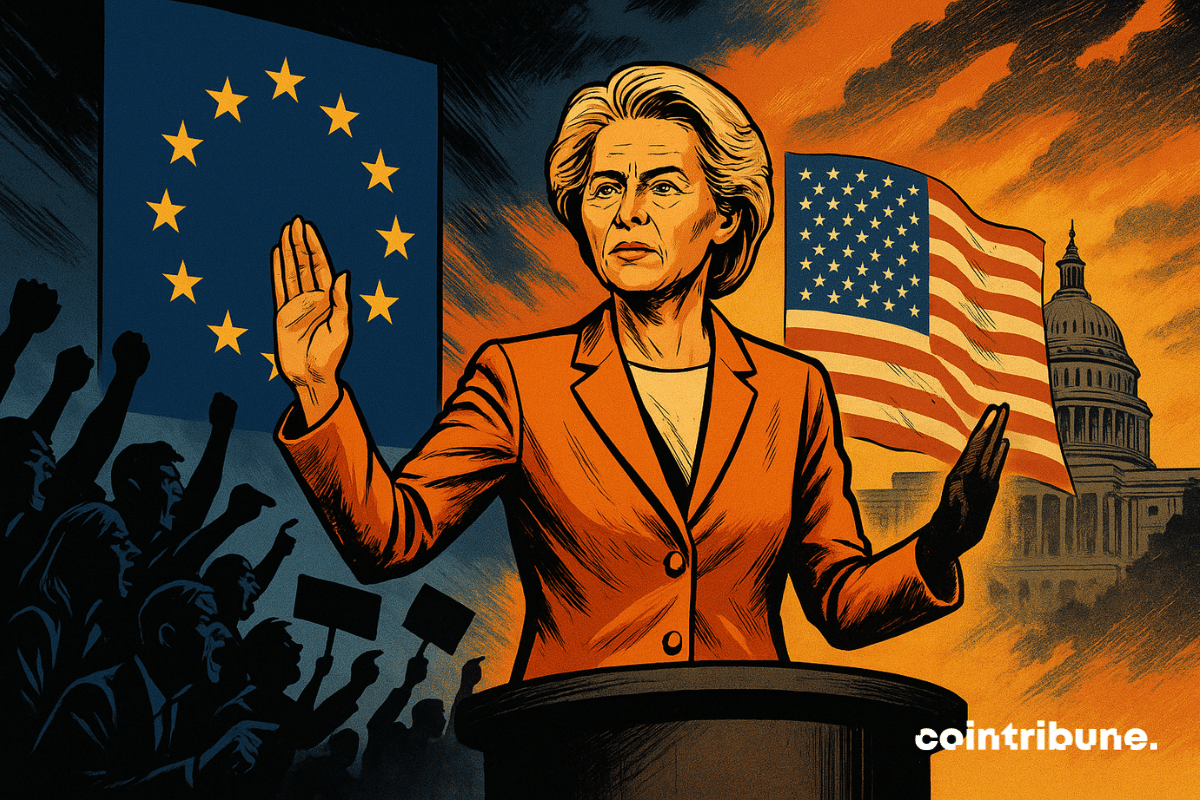In the midst of geopolitical reshuffling, the European Union and the United States have just ratified a trade compromise presented as a bulwark against escalation. Supported by Ursula von der Leyen, but strongly criticized by Mario Draghi, the text crystallizes a European dilemma: guaranteeing transatlantic stability or fully defending the continent's industrial interests. Between diplomatic balance and tariff concessions, this new agreement revives the debate on Europe's economic sovereignty. L’article US-EU Deal Sparks Political Tensions In Europe est apparu en premier sur Cointribune. In the midst of geopolitical reshuffling, the European Union and the United States have just ratified a trade compromise presented as a bulwark against escalation. Supported by Ursula von der Leyen, but strongly criticized by Mario Draghi, the text crystallizes a European dilemma: guaranteeing transatlantic stability or fully defending the continent's industrial interests. Between diplomatic balance and tariff concessions, this new agreement revives the debate on Europe's economic sovereignty. L’article US-EU Deal Sparks Political Tensions In Europe est apparu en premier sur Cointribune.
US-EU Deal Sparks Political Tensions In Europe

In the midst of geopolitical reshuffling, the European Union and the United States have just ratified a trade compromise presented as a bulwark against escalation. Supported by Ursula von der Leyen, but strongly criticized by Mario Draghi, the text crystallizes a European dilemma: guaranteeing transatlantic stability or fully defending the continent's industrial interests. Between diplomatic balance and tariff concessions, this new agreement revives the debate on Europe's economic sovereignty.
L’article US-EU Deal Sparks Political Tensions In Europe est apparu en premier sur Cointribune.
Disclaimer: The articles reposted on this site are sourced from public platforms and are provided for informational purposes only. They do not necessarily reflect the views of MEXC. All rights remain with the original authors. If you believe any content infringes on third-party rights, please contact service@support.mexc.com for removal. MEXC makes no guarantees regarding the accuracy, completeness, or timeliness of the content and is not responsible for any actions taken based on the information provided. The content does not constitute financial, legal, or other professional advice, nor should it be considered a recommendation or endorsement by MEXC.
You May Also Like

Understanding the Ethereum Interoperability Layer (EIL): Bridging L2 Fragmentation and Building a Seamless Cross-Chain Experience
Author: Pan Zhixiong Ethereum has successfully addressed the scaling issue over the past few years by deploying multiple Layer 2 solutions, such as Arbitrum, Optimism, and Base, resulting in reduced transaction costs and increased efficiency. However, this has led to a fragmented user experience: each L2 network acts like an isolated island, with users facing cumbersome steps, different bridging protocols, and complex asset and gas management when crossing chains. To address this pain point, the Ethereum core team recently proposed the Ethereum Interop Layer (EIL). To understand EIL, we first need to review its foundation—ERC-4337. ERC-4337 is an account abstraction standard proposed by Ethereum. It requires no changes to the underlying Ethereum protocol, implementing a new type of account structure—the smart account—simply by deploying smart contracts. This type of account not only supports advanced features such as social recovery, multisignature, and batch operations, but also allows for gas payments using ERC-20 tokens via smart contracts. However, despite the many technological innovations brought by ERC-4337, its adoption in practice remains limited. Fragmented user experience, difficulties in multi-chain collaboration, high gas costs, and ecosystem compatibility issues all restrict the widespread adoption of 4337. The EIL was developed to address these issues on top of ERC-4337. EIL is an additional multi-chain interoperability protocol built upon the ERC-4337 framework . It extends the single-chain account abstraction to multi-chain account interoperability, enabling a seamless experience across multiple L2 networks. Specifically, EIL implements two important innovations: one-signature multi-chain operations (bulk authorization) and a competitive funding mechanism for cross-chain liquidity providers (XLPs). The first innovation, bulk authorization , allows users to authorize multiple operations across multiple L2 networks with a single signature. Specifically, the wallet first constructs its own UserOperation on each relevant chain, then integrates these operations into a Merkle tree. Users only need to sign the root of the tree once. When a smart account on each chain verifies a received UserOperation, it only needs to verify that it belongs to the Merkle tree and that the signature is valid to execute the operation. This approach significantly simplifies the cross-chain operation process for users. The second innovation, the auction-based funding mechanism, introduces a role called Cross-chain Liquidity Provider (XLP). XLPs are responsible for providing asset transfer and gas payment services between different chains. When a user locks assets on the source chain and submits a cross-chain request, multiple XLPs can bid on the request through on-chain auction. The XLP that wins the bid provides a cross-chain asset transfer voucher, allowing the user to directly obtain funds and gas payments on the target chain to complete the required cross-chain operation. Only after the transaction is completed will the XLP claim the user's previously locked assets on the source chain. To ensure security and fairness, XLPs must be staked on the Ethereum mainnet (L1) and subject to a strict dispute arbitration mechanism. If an XLP violates the rules, the staked assets will be forfeited, thus ensuring its integrity through economic incentives . It's worth emphasizing that EIL doesn't require any changes to the consensus protocol of the Ethereum mainnet or L2 network during its implementation . All implementations are based on smart contracts and the existing ERC-4337 account abstraction framework. This design not only reduces the difficulty of implementation but also significantly reduces the security risks the chain itself may face. Of course, this design also shifts the pressure and complexity to the wallet and off-chain infrastructure . The wallet needs to support complex multi-chain transaction construction, one-signature multi-chain verification, interaction mechanisms with CrossChainPaymaster and XLP, and needs to provide a simple and user-friendly interface. The off-chain infrastructure, on the other hand, needs to build a robust auction market, monitor XLP fund flows in real time, and manage risks. Ultimately, EIL provides users with a single-chain-like experience. In the future, when users open EIL-enabled wallets, they will no longer need to frequently switch chains, manage cross-chain assets, or endure lengthy cross-chain waits and cumbersome procedures. All complex cross-chain details will be completed automatically outside the user's view, gradually unifying the user experience across the entire Ethereum L2 ecosystem and truly realizing the vision of multi-chain integration and seamless interoperability. EIL also opens up a whole new possibility for the entire Ethereum ecosystem: it not only solves the cross-chain user experience problem, but more importantly, it truly allows multiple L2 networks to "become one" in a secure, decentralized, and trustless way.
Share
PANews2025/11/21 14:00

Nomura Alters Fed Rate Cut Prediction for 2025
Detail: https://coincu.com/markets/nomura-fed-rate-cut-forecast-2025/
Share
Coinstats2025/09/18 12:39

The whale "66kETHBorrow" purchased another 7,837 ETH, bringing its total holdings to 440,500 ETH.
PANews reported on November 21 that, according to Lookonchain, the whale "66kETHBorrow" has purchased another 7,837 ETH (approximately $21.9 million), bringing its total holdings to 440,500 ETH, with a total value of approximately $1.23 billion at the current price.
Share
PANews2025/11/21 14:27
